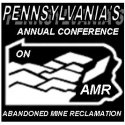Pine Creek is the largest tributary of the West Branch Susquehanna River and has the largest watershed of all the West Branch’s tributaries Potter, Tioga, Lycoming, and Clinton counties in Pennsylvania. The creek is 87.2 miles long. Within Tioga County, 23.25 miles of Pine Creek are designated as a Pennsylvania Scenic River (excerpt from Wikipedia).
The Pine Creek Headwater’s Protection Group (PCHPG) was established in 1987 to promote the local citizens awareness of the high value of Pine Creek, to emphasize its uniqueness as a natural resource, and to show it can be preserved for aquatic life, wildlife, and for all people to appreciate and use. See the Pine Creek Headwaters Protection Group website.
Babb Creek
With the discovery of coal in 1782 in Blossburg and the development of the railroads from 1865-1895, mining in the Babb Creek Watershed began. By 1865 Arnot Mines was established and grew to a population 4,000 by 1880. Other companies popped up throughout the watershed like the Klondike Mine, Antrim No. 1 Mine (1872), Bear Run Mine (1888) and town of Landrus, Anna S Mine (1895) and Rattler Mine by the early 1900’s. Various surface mining operations were underway from the 1950s-1980s.
By 1990 Babb Creek was dead and sterile. A stream survey showed no fish and very little macroinvertebrate life in the main stem of Babb Creek and in Lick Creek. A pollution plume was observed in Pine Creek for 5 miles to Cedar Run. DEP contacted and asked for assistance and the PEDF took on the task of cleaning up the watershed.
In 1990, the first treatment devices (diversion wells) in the watershed were constructed to treat acidity in Lick Creek. The Antrim Mining Company constructed a treatment plant to treat the Antrim No. 1 and Backswitch Discharges. In 1996, A large SAPS and buried limestone drain were constructed using a state grant to treat the Arnot Discharge. In 1998, additional diversion wells were constructed by volunteers to treat Red Run. The treatment raises the pH from 4.0 to 6.5. Also that year, the Klondike Treatment System was excavated by DEP’s BAMR construction crew, the materials were purchased through a state grant and the work was done by Signor Bros. Construction.
In 1999, coal mine refuse at the Klondike Mine was reclaimed by the Babb Creek Watershed Assoc. using topsoil and tannery sludge materials. In 2000 two large vertical flow ponds were constructed to treat the Bear Run Mine pollution and approximately 3,000 feet of railroad grade composed of coal and coal refuse were removed by Signor Brothers Contracting through a DEP mining permit. The stream was eroding the material and causing siltation in Babb Creek.
In 2002, the State Yard passive treatment system including vertical flow ponds, a settling basin, and manganese treatment was constructed with a DEP Growing Greener Grant and over 90 Acres of abandoned mine land at the Rattler Mine were revegetated using biosolids. The project was funded by an OSM grant, BCWA funds, Game Commission resources, and other grants and donations. A new approach of injecting limestone sand slurry into the abandoned Rattler underground mine workings was also being done as part of a Growing Greener Grant.
In 2003, passive treatment at three sites associated with the Ratler Mine was accomplished through Growing Greener and OSM funding and passive treatment of the Anna S discharges and Hunters Drift was completed as part of a $2.5 million project funded by Growing Greener and OSM.
Before going out of business, the Antrim Mining Company constructed a more economical treatment plant and established a $1.5 million treatment trust for its operation. The plant is operated by the Babb Creek Watershed Association under an agreement with DEP.
Recovery Evidence
By 2016 the section of Pine Creek that was polluted by Babb Creek was officially removed from the 303(d) list of impaired streams. Lick Creek is a recovering fishery. Shallow headwater ponds are supporting panfish. Wild trout are reproducing in Babb Creek near Landrus. Sixteen types of fish were found at the mouth of Babb Creek. The restaurant in Morris is now called “The Babb Creek Inn”. Kids are fishing Babb Creek again. Pine Creek Anglers have complained about the Babb Creek restoration efforts because some hatches have been too prolific and fish have too many ‘real’ flies to eat and don’t take the ‘artificial’ flies. Some of Pine Creek’s insect hatches including the ‘Green Drake’ have returned after being absent for many years (excerpt from Restoration of the Babb Creek Presentation from Babb Creek Watershed Association).
Reports on the Watershed:
Pine Creek Watershed Conservation Plan











